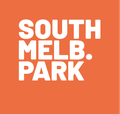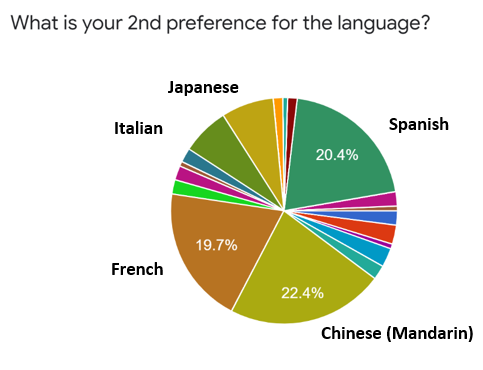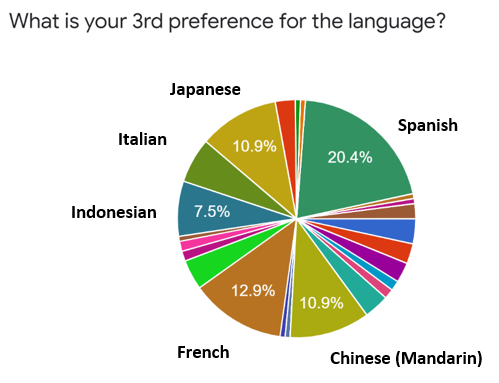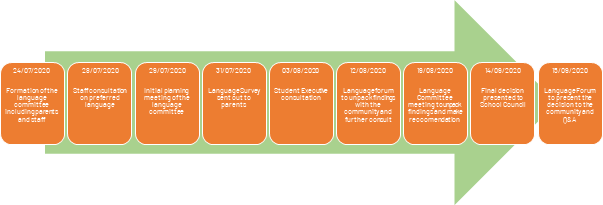
Principal's
Message
BE INVOLVED, BE CONNECTED
LANGUAGES OTHER THE ENGLISH (LOTE) - SPANISH
We have had such an exciting and unique opportunity as a brand-new school to set the direction for the language tuition moving forward. Normally schools continue with the language they have always taught historically, because of how embedded it has become in the community and the staffing implications associated with changing the language. We have this chance to ‘inspire the next generation of curious minds’ and really consider what language would be the most appropriate for our school and our community.
When selecting a language for our school we were very aware that we need to take into account the views of our staff, students, parents and wider community to provide our students with the best possible offering that we can. One of the most important elements to this decision-making process was to be clear on what the purpose of teaching a language at South Melbourne Park Primary is.
Our LOTE committee developed a purpose statement to guide our decision making, which you can see below:
At South Melbourne Park Primary School our language program aims to provide an opportunity to expose children to a rich culture and history, the basics of understanding the mechanics of how languages work and provide a foundation for the students to explore in their future. We value opportunities for worldwide connection and global citizenship
.
This purpose statement became the filter through which we interpreted the data we collected from parents, staff and students.
As you can see from the parent survey results, there was consistently three top languages that were preferred by our community: Mandarin, French, and Spanish. The results were as follows:
- 1st language preference- Chinese 27.9%/ French 23.1%/ Spanish 18.4%
- 2nd language preference- Chinese 22.4%/ Spanish 20%/ French 19.7%
- 3rd language preference- Spanish 20.4%/ French 12.9%/ Chinese 10.9%
We could see that families appeared to be either strongly committed to French, Mandarin or Spanish. Furthermore, from both the feedback listed in the comments of the survey, the conversations at the parent forum, and anecdotal conversations there were families that were opposed to the teaching of French or Mandarin. This was due to concerns about unfair advantage of a portion of the community speaking it at home, difficulty of the language, or lack of interest in the language the family is already familiar with.
What we found when we looked deeper into the results Spanish was represented diversely and was a language that everyone seemed comfortable with. Furthermore, it is a Latin-based language which has strong ties to understanding the mechanics of the English language, has a rich and vibrant culture for students to learn about, and is one of the most widely spoken languages in the world.
The language committee carefully considered all perspectives and took into account all feedback. This was a very hard decision, especially as there were clearly three languages that were all consistently preferred. We know that some families will be disappointed, however by looking at the core values of the school and the purpose of selecting a language the committee decided that Spanish would be the language that would ‘inspire the next generation of curious minds’.
FREQUENTLY ASKED QUESTIONS
Why do schools in Victoria offer a language of study?
Research shows that learning a second language boosts problem-solving, critical-thinking, and listening skills, in addition to improving memory, concentration, and the ability to multitask. Children proficient in other languages also show signs of enhanced creativity and mental flexibility.
The Victorian Government requires all primary government schools to teach a language from Prep level to Year 6.
How often will the students study the language and for how long?
Spanish will be taught as one of our specialist lessons, 50 minutes per week for all students.
When will the language program start?
The language program will start for all students in Term 1 2021.
Will my child learn about the history and the culture associated with the language?
Absolutely. One of the core reasons that we teach language in primary schools is to expose our children to a different culture and allow them to learn about how different people live and think. This is a really rich and exciting part of the program.
Will my child become fluent in the selected language?
No, it is unlikely. Fluency requires immersion and a greater time period of focused practice. Students will become familiar with the language and be able to understand and speak basic phrases as well as understand the basic mechanics of the language. The purpose of teaching a language at primary school is to start exposing children to the mechanics of language, not primarily to enable them to be fluent in it. Furthermore, Spanish is one of the easiest foreign languages for English speakers to learn. Much of the vocabulary Is similar to English, and Spanish Is a phonetic language, which means that the words are pronounced the way they are written.
What was the consultation process for the selection of the language?
We value consultation incredibly at South Melbourne Park Primary School, and we have taken a number of avenues to enable all our families to have input and to have a say in the language that we have selected. We had 151 families respond to our survey, and we had approximately 25 families join us for our language forum where we unpacked the findings from our process and further discussed any questions or thinking. Please find our process below:
How will this language help my child with literacy?
Spanish is a Latin-based language and has a close relationship to English. There are a lot of English words that have their background, or etymology, in English and learning this language will help our students in understanding where these words have come from. Furthermore, learning the different structure and mechanics of the language will help all our students in their understanding of how languages work, and will support them in learning further languages in the future.
How will this language be useful for my child’s future?
Spanish is one of the most widely spoken languages in the world. It is spoken across a diverse range of countries and is globally a dominant language. Furthermore, Spanish has clear linguistic links to French, Italian, Portuguese, Romanian, and Dutch. The advantage of learning a Latin-based language is that it provides easier access to these other languages. Spanish is a language that opens doorways for employment, as it is a very travelled language and many employment opportunities look favourably on Spanish as an additional language.
How is this language going to help my child in secondary school?
The secondary schools in our area mostly teach French. This is mostly due to historical reasons. As you have seen through our consultative process, we decided against teaching French to opt for the language that was more equitably favoured across the community. However, Spanish, being a Latin-based language with close ties to French, will serve as a strong foundation for any French tuition. Furthermore, secondary schools will start their language instruction in Year 7 with the basics, as their students will be coming from a diverse range of schools that all teach different languages, and we do not want our students to be bored covering content they are already familiar with.
How easy will it be to find a teacher for this language?
We don’t know until we hire! However, as you will be aware, we have a very rigorous hiring process here at South Melbourne Park Primary School. We are passionate about having the best teachers for your children, and we invest the time and energy to ensure that this is the case.
How did the backgrounds of families or the language spoken at home factor into the decision-making process?
When looking closely at the data of both the parent survey and the 2020 school census data we note that we have approximately 24 different languages that are spoken at home. We believe that students would benefit learning a language that is different to their home background as it provides students greater opportunities to learn something new including the culture, geography and history of another country. At the primary level we cover the fundamentals, if the language of study is the same to the one spoken at home, students may become disengaged.
Will the language change in the future?
It is unlikely. While anything can change and we cannot guarantee that this will always be the language of study at our school, we intend for this to be our language for the foreseeable future.
How will my child be able to learn this language in the future?
Fluency in a language requires more than just a single session, it requires intense and continuous study. There will be many opportunities outside of school to further peruse this language of study. One such opportunity is the Victorian School of Languages. This actually started at MacRobertson Girls School and is now a program that offers tuition in over 40 different languages.
Can the school offer more than one language?
Not within the core curriculum. In order to offer a language, we need to employee a teacher, and we have funding that will cater for a specific number of specialist teachers. We can explore external tuition that is opt in and paid for by parents, much in the same way that we have started to explore optional Auslan classes for our families to engage in.
LOTE-SPANISH PARENT FORUM Q & A-THURSDAY 8TH OCTOBER
We are holding a parent forum on 8th of October from 6:00 pm to 7:00 pm. This is an opportunity for parents to ask any questions they may have about our process in selecting a language and the decision that we made. We will also be going through the findings presented in this newsletter. Please RSVP by 5:00 pm Wednesday the 7th of October.
RETURN TO SCHOOL
5-9th October (first week of Term 4)
Remote and flexible learning continues for all students.
12- 16 October (second week of Term 4)
Students in Prep to Year 2 return to full-time on-site schooling. Remote and flexible learning will continue for all students in Year 3-6 until further notice. A date for the return of these year levels to on-site learning will be subject to further health advice.
END OF TERM
We have come to the end of the term. Thank you to the teachers, support staff and parents for your positivity and for having ‘’kids at the heart” and “playing as a team”. We have really valued your partnership during remote learning. I have really enjoyed looking at the work the students have produced on Seesaw and the live lessons have enabled the students to be more connected with their teacher and peers. During the term, teachers have been assessing students as best as they can, in preparation for students’ return to school. In Term 4 our priorities will be:
- Wellbeing: The wellbeing, and particularly the mental health of every student is the highest priority.
- Learning and Excellence: Some students have been better able to progress in their learning in the remote and flexible learning environment, others have maintained their rate of progress, and some have, despite their best efforts and those of their families and teachers, not progressed in learning. Our teachers are planning curriculum to meet all students at their point of need, with a strong focus on Literacy and Numeracy.
- Transitions: Term 4 is a critical period for children moving from kindergarten into Prep, from Year 6 into Year 7. Students in other year levels will also be prepared for a change in teacher and new classmates.
Even though remote schooling is closed for the next two weeks, we hope that families have a holiday away from screens, so that brains can recharge, and students are ready for Term 4.




